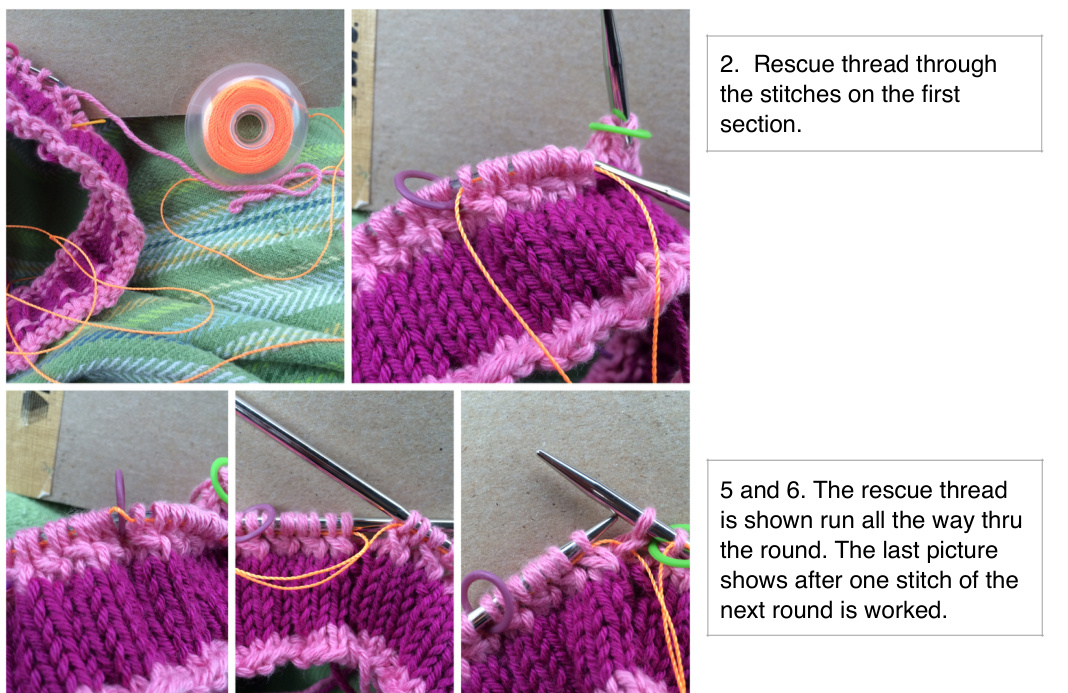Hat #34 Cable Dropped Stitches
| Details about the Project Picture | |
| Hat #34 Cable Dropped Stitch | |
| Multiple | pattern8stitchesover5 rounds |
| Needle | Size 6 |
| Cast on | 100stitches |
| Finished size | Adult medium |
| Plymouth Jeannee worsted weight | |
| 51% cotton, 49% acrylic | |
| main color | 06 greyish pale moss green |
| contrast color 2 | 39 silver brownish gray |
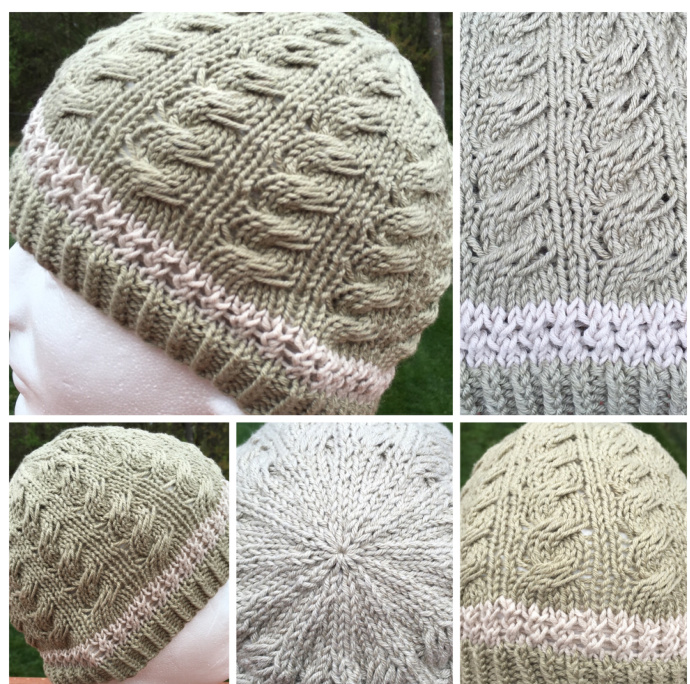
| Supplies | #7 Needles in preferred in the round method (16" circular, long circular for magic | ||
| loop,2 circulars orDPNs)forribbingrounds | |||
| Needles for decreasing (long circular for magic loop, 2 circulars or DPNs) | |||
| Tapestryneedleforweaving inends | |||
| worsted weight yarn (recommend a light worsted). I used a cotton blend here. | |||
| (Note that the amounts are APPROXIMATE, I didn't measure exactly): 120 yards main color, 30 yards contrast color | |||
| A Note about Size | |||
| and with the #6 needles, this hat fit me about perfectly. I have an average size woman's head. | |||
| Casting On | |||
| n 'l! alooh uo nd ln buol u op ot moy ual on alp,no fl oon yom lm n buol sina isnr (oon nd | |||
| are several good sites. | |||
| Joining in the Round | If you don't know how to do this, there are TONS of online resources. My preferred | ||
| method is to cast on one extra stitch and pass it over. Just make sure your work isn't twisted! | |||
| Rescue Row | Also sometimes called a lifeline. If you are worried about a mistake, I recommend a | ||
| Rescue Row now and then to add to your peace of mind. What you basically do is run a slender piece of yarn or thread (l use | |||
| a bright color nylon thread because I can see it and it's slippery and easy to pull out later) through the stitches. This way if I | |||
| have to pull out my work later because of a mistake, Ill have these "correct" stitches saved on that thread and they'll be easy | |||
| sure you go OUTSIDE of any stitch markers. When the project is done, just pull the rescue row out. Lots of info online. | |||
Hat #34 Cable Dropped Stitches
| Abbreviations | |||||
| k | knit | ||||
| p | μund | ||||
| sl-1 | |||||
| If nothing is said otherwise, you always slip a stitch purlwise (like you were | |||||
| going to purl it) with the yarn in back (wyib) (on the knit side). | |||||
| k2tog | knit 2 together (go thru 2 stitches at same time & knit them together) | ||||
| repeat thedirectionsbetweentheasterisksover&overforentireround | |||||
| k-tbl | knit through the back loop. Instead of knitting through the front of the next stitch (as a normal knit | ||||
| stitchwould be done)you knit through theleg of thestitch on theback of the stitch(behind the | |||||
| left needle). This twists the stitch and gives it a little decorative pop. | |||||
| C6B | Cable6back.TheCmeanscable,the6meansatotalof6stitchesareinvolved,theBmeansthe | ||||
| cable will be held to the back.How to work it: Slip 3 stitches onto a cable needle and hold to the | |||||
| back, knit 3, then knit the 3 stitches from the cable needle (most directions say to work them from | |||||
| the cable needle, I prefer to put them back on the left needle and work them from there.) | |||||
| RT-a | There are several ways to make a Right Twist. I'm calling this one Right Twist-a (RT-a). Knit 2 stitches | ||||
| together but do NOT take the off the left needle. Instead, put your right needle back into the first | |||||
| stitch andknit itagain.NOWslidebothstitchesoff. | |||||
| StitchMarkers | Stitch markers are awesome. They make my knitting life SO much easier. I personally like the | |||
| thin, silicone ring type. The hard plastic ones have a tendency to run away from me sometimes, the silicone ones seem to stick | ||||
| to the needles better. But you could use any kind, or even scrap yarn tied into a circle. Here are a few ways they help me here. | ||||
| Castingon | Pattern calls for 100 stitches. 100 can be divided by 10, 10 times. | |||
| So, before I even start casting on, I get out 10 stitch markers and lay them out. I always use a bright green one to designate the | ||||
| beginning of my round. As I'm casting on, every time I reach 10 stitches, I double check my count and place a stitch marker. | ||||
| When all my markers are used up, I have the amount of stitches I need (although I'll usually go back and count the markers | ||||
| to make sure I really have the right amount - errors have been known to happen). | ||||
| Pattern | The pattern repeats are in sections. You just repeat them | |||
| over and over around.lf you aresupposed to end a sectionwith a knit 3 and yetsomehowyou only haveknit 2, youknow you | ||||
| Note that you start out with 8 stitch sections and change to 12 stitch sections for the pattern rounds. | ||||
Hat #34 Cable Dropped Stitches
| There are several mini tutorials at the end if you need them. | |
| Use#6needle.Layout12stitchmarkers.Withmaincolorandusingthelongtailcastonmethod,cast | |
| on96 stitches,placing markersevery8stitches.Your distinctivebeginning of round marker | |
| willbethelastoneplaced.Iusuallyneedtopulloutabout80inchesof"tail"yarntocast | |
| on this number using the long tail cast on with this needle size. | |
| Edge & Ribbing Round with maincolor | * k1-tbl | p1 |
Repeat Ribbing Round until about 1" long
| DecorativeRounds | |
| Decorative Round1 withcontrastcolor | knit |
ping the first stitch of the next round helps minimize the jog created by the color c
| DecorativeRound2 sl-1 withcontrastcolor | *knit* | |
| DecorativeRound3 withcontrastcolor | RT-a 大 |
| DecorativeRound4 withcontrastcolor | knit | ||
| DecorativeRound5 withcontrastcolor | ¥ RT-a * |
| DecorativeRound6 withcontrastcolor | knit |
| DecorativeRound7 withmaincolor | knit |
| DecorativeRound8 withmaincolor | Sl-1 *knit* |
Hat #34 Cable Dropped Stitches
| Pattern Rounds | ||||
| Pattern Round 1 with main color | knit | |||
| Pattern Round 2 knit | ||||
| with main color | ||||
| As you do the double wraps on the next round, you don't need to do the wraps tightly, the stitches on the next round will be tight anyway. | ||||
| Pattern Round 3 with main color | * k1 | *k6 (wrapping yarn twicearoundneedlefor each stitch) | k1 * | |
| The stitches willbe tight and difficult to move on the next round, it's helpful to have a pillow on your lap. | ||||
| Pattern Round 4 with main color | * k1 | C6B letting extra stitches drop | k1* | |
| C6B-put 3 stitches on cable needle and hold to back,k3, then k3 from cable needle | ||||
| Pattern Round 5 with main color | knit | |||
| Pattern Round 6 with main color | knit | |||
| Pattern Round 7 with main color | knit | |||
| Pattern Round 8 | * k1 | * k6 (wrapping yarn twicearoundneedlefor | k1 * | |
| with main color | each stitch) | |||
| Pattern Round 9 with main color | * k1 | C6B letting extra stitches drop | k1* | |
| C6B-put 3 stitches oncable needle and hold toback,k3,thenk3from cable needle | ||||
Hat #34 Cable Dropped Stitches
| Pattern Round 10 with main color | knit | ||
| If you think it might be helpful to you,this would be a good place to insert a rescue row | |||
| Pattern Round 11 | knit | ||
| withmain color | |||
| PatternRound12 with main color | knit | ||
| PatternRound13 withmain color | *k1 | *k6 (wrapping yarn twicearoundneedlefor each stitch) | k1 * |
| Pattern Round 14 * k1 withmain color | C6Blettingextra stitches drop | k1* | |
| C6B-put3stitchesoncableneedle andhold toback,k3,thenk3fromcableneedle | |||
| Pattern Round 15 with main color | knit | ||
| Pattern Round 16 with main color | knit | ||
| Pattern Round 17 with main color | knit | ||
| Pattern Round 18 | * k1 | *k6 (wrapping yarn twicearoundneedlefor | k1 * |
| with main color | each stitch) | ||
| Pattern Round 19 with main color | *k1 | C6B letting extra stitches drop | k1* |
| C6B-put3stitchesoncableneedle and hold toback,k3,thenk3fromcableneedle | |||
| Pattern Round 20 | knit | ||
| withmaincolor | |||
| Pattern Round 21 with main color | knit | ||
Hat #34 Cable Dropped Stitches
| Pattern Round 22 with main color | knit | ||
| Pattern Round 23 with main color | * k1 | *k6 (wrapping yarn twicearoundneedlefor | k1 * |
| each stitch) | |||
| Pattern Round 24 with main color | *k1 | C6B letting extra stitches drop | k1* |
| C6B- put 3 stitches on cable needle and hold to back, k3, then k3 from cable needle | |||
| Pattern Round 25 with main color | knit | ||
| If you think it might be helpful to you, this would be a good place to insert a rescue row | |||
| Pattern Round 26 with main color | knit | ||
| Pattern Round 27 with main color | knit | ||
| PatternRound 28 | * k1 | ||
| with main color | * k6 (wrapping yarn twicearoundneedlefor each stitch) | k1 * | |
| Pattern Round 29 with main color | *k1 | C6B letting extra stitches drop | k1* |
| C6B - put 3 stitches on cable needle and hold to back, k3, then k3 from cable needle | |||
| Change to whatever needle style you prefer for decreasing in the round - magic loop (my | |||
| preferred method),double-pointed needles,or two circulars. | |||
| DecreaseRounds | |||
| DecreaseRound1 with main color | * SSK k4 | k2tog * | |
Hat #34 Cable Dropped Stitches
| Decrease Round 2 with main color | * k6 * | ||
| DecreaseRound3 | * SSK k2 | k2tog * | |
| with main color | |||
| Decrease Round 4 with main color | * k4 * | ||
| Decrease Round 5 with main color | * k4 * | ||
| Decrease Round 6 with main color | * k2 k2tog * | ||
| Decrease Round 7 with main color | *k3* | ||
| DecreaseRound8 with main color | * k3 * | ||
| Decrease Round 9 with main color | *k1 k2tog * | ||
| Remove all but beginning of round markers as you work the next round | |||
| DecreaseRound10 with main color | * k2 * | ||
| DecreaseRound11 with main color | * k2tog * | ||
| Cut your yarn, leaving about a 12" tail. Thread the tail onto a tapestry needle. | |||
| Go through the stitches on your needles (in the same direction like you were going to knit them). | |||
| Slide them off your knitting needles. Tighten them up, cinching the top of the hat. Thread theend throughto theinsideof thehat.Securelysewintheends and trimoffextra. |
Mini Tutorial Cable Double Wrap & Drop Stitch
1. Wrap the yarn as you would a normal knit stitch.
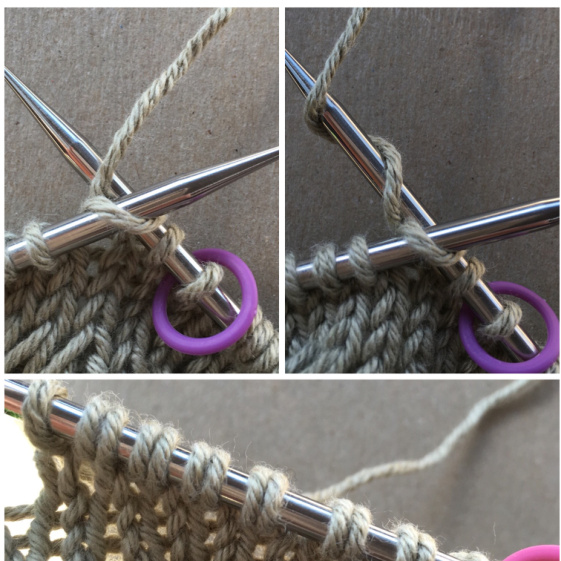
3. The double wrapped stitches will look like twins on the needle. They will be very tight to work with on the next round. This is normal, you didn't do anything wrong. 1. This is how your stitches will look after you've moved them to the cable needle. See below for how to do it.
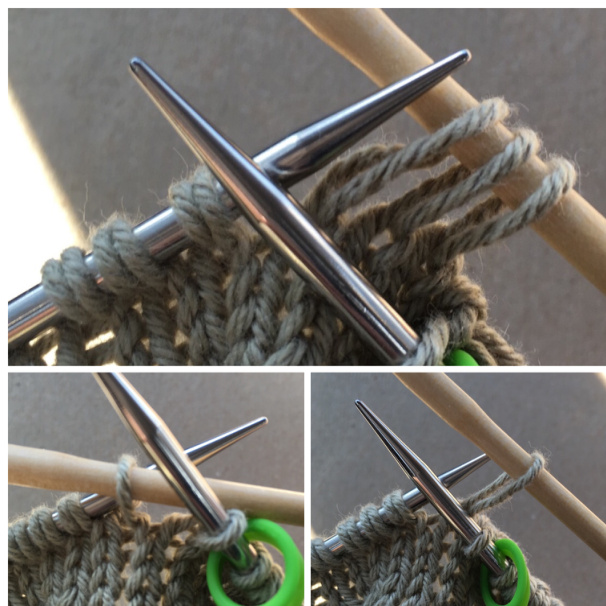
2. Insert the cable needle purlwise into the stitch and tug it off so that the extra wrap drops of. 3. Here the stitch has been transferred tothecable needle and the extra wrap was dropped. 1. You'll have to kind of hold the cable needle with thosereally long stitches behind. Knit the first stitch, tugging it off the left needleso the extra wrap drops off.
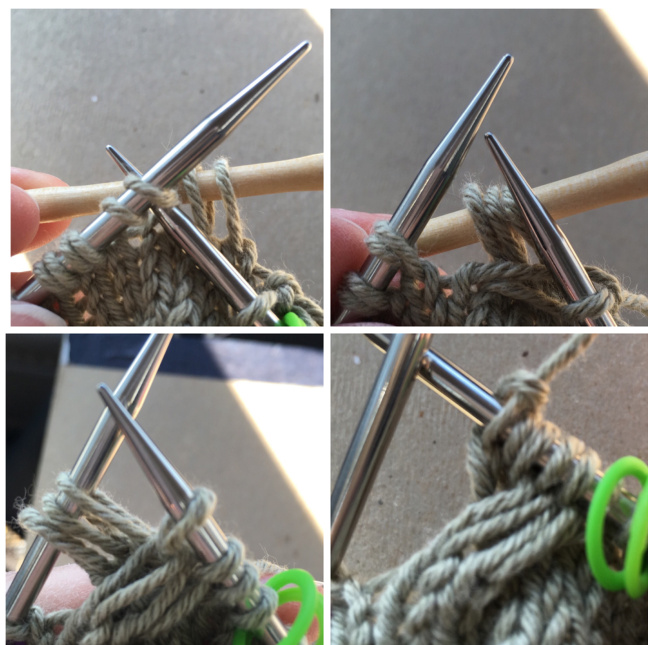
2. One stitch has been worked (you can see how long it is)
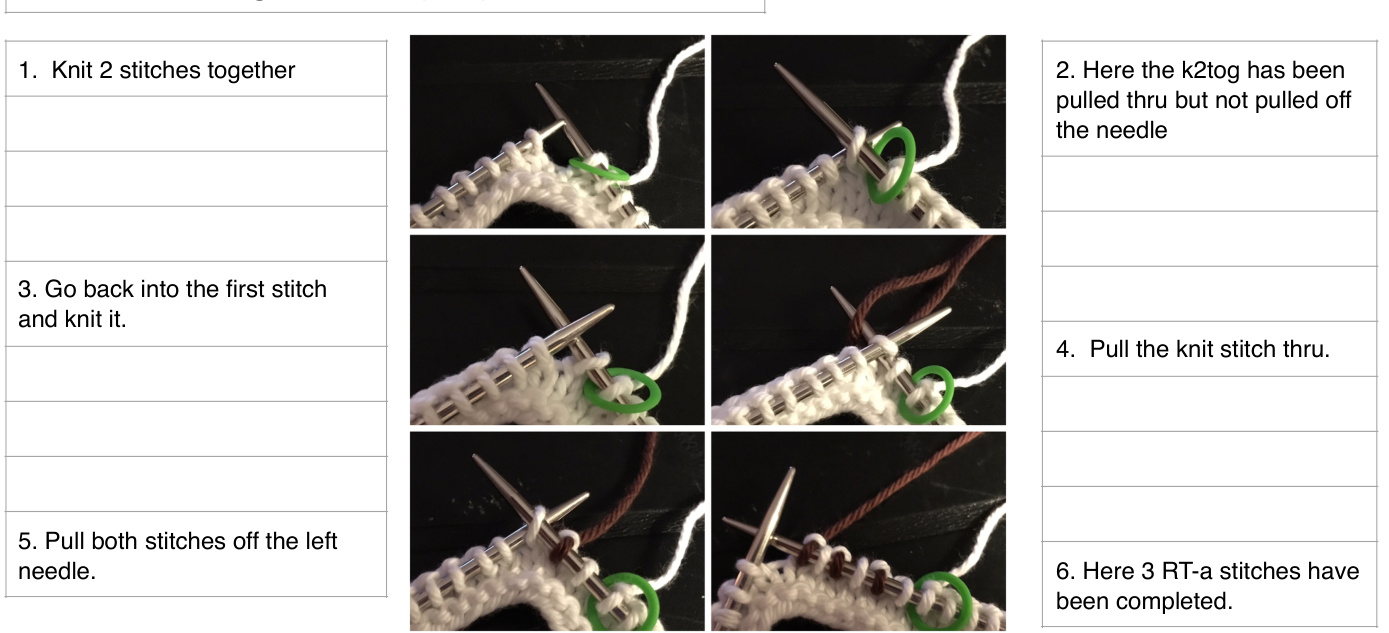
Mini-Tutorial Rescue Row
1. I use a thin, bright nylon thread. I keep some wound on a yarn bobbin (Knit Picks) so it's portable and stays neat. 3. Note that the thread needs to go OUTSIDE of stitch markers.
